Abstract
Negative air ions (NAIs) are crucial for assessing the impact of forests on wellbeing and enhancing the physical and mental health of individuals. They serve as pivotal indicators for assessing air quality. Comprehensive research into the distribution patterns of NAI concentrations, especially the correlation between NAI concentrations and meteorological elements in tourist environments, necessitates the accumulation of additional long-term monitoring data. In this paper, long-term on-site monitoring of NAI concentrations, air temperature, relative humidity, and other factors was conducted in real time over 24 h, from April 2020 to May 2022, to explore the temporal dynamic patterns of NAIs and their influencing factors. The results showed that (1) the daily dynamics of NAI concentrations followed a U-shaped curve. The peak concentrations usually occurred in the early morning (4:30–8:00) and evening (19:10–22:00), and the lowest concentrations usually occurred at noon (12:50–14:45). (2) At the monthly scale, NAI concentrations were relatively high in February, August, and September and low in January, June, and December. At the seasonal scale, NAI concentrations were significantly higher in winter than in other seasons, with higher concentrations occurring in the summer and autumn. (3) Relative humidity, air temperature, and air quality index (AQI) were the primary factors that influenced NAI concentrations. Relative humidity showed a significant positive correlation with NAI concentrations, while air temperature and AQI both exhibited a significant negative correlation with NAI concentrations. Higher air quality corresponds to higher NAI concentrations. Our research provides new insights into NAI temporal dynamics patterns and their driving factors, and it will aid in scheduling outdoor recreation and forest health activities.
1. Introduction
Negative air ions (NAIs) is a generic term for negatively charged gas molecules and ions. Based on variations in their electron-capturing abilities, most electrons are acquired by oxygen, resulting in the formation of NAIs [,]. Forests are the most active ecosystem in releasing NAIs, and high concentrations of negative oxygen ions have become an important forest tourism resource, garnering increasing attention from the public [,,]. Studying dynamic changes in NAI concentrations in high-concentration environments is essential for assessing individual wellbeing [,]. This is particularly relevant in the investigation of world cultural heritage sites, which are major tourist attractions. Understanding fluctuations in NAI concentrations in these areas not only establishes a scientific basis for evaluating air quality but also provides theoretical support for travel planning [,,]. This study not only enhances our understanding of the correlation between NAI concentrations and forest therapy but also provides valuable insights for refining the design of forest therapy interventions, thereby enriching the overall experience for individuals [,,,,,,]. Consequently, acquiring a thorough understanding of the temporal trends in NAI concentrations establishes a theoretical foundation for connecting NAI concentrations with health, travel planning, and forest therapy. This offers essential guidance for elevating individual wellbeing and optimizing the overall travel experience. In these studies, the FR500 instrument is capable of measuring NAIs over a wide range of particle sizes and mobilities ≥ 0.4 cm2/Vs. One would expect that the authors’ measurements of NAIs mostly include large and intermediate air ions, with only a small fraction of the NAIs measured being small air ions with mobilities of 15,000 cm2/Vs or greater []. Historically, small, very mobile air ions have been the focus of interest as to the potential benefits of NAI exposure on health and wellbeing [,].
NAI concentrations exhibit certain diurnal and seasonal variations. On the daily scale, NAI concentrations tend to be higher from midnight to early morning, gradually decreasing around noon, and increasing again in the evening, forming a U-shaped distribution. At times, the regular pattern may be less evident due to external factors [,]. Additionally, geographical regions, species composition, and passenger flow can also lead to variations in the timing of NAI concentration peaks and valleys [,,]. At the seasonal scale, NAI concentrations were generally higher in the summer and autumn compared to winter and spring [,], although seasonal changes in some regions may not be consistent and could be influenced by combined factors such as the location of the observation area and weather variation [].
The influencing factors of NAIs primarily include meteorological conditions (air temperature, relative humidity, etc.) [,], environmental factors (atmospheric pollution, air quality index, etc.) [,,], and vegetation types (species richness and abundance, etc.) [,,]. Due to the combined effects of various meteorological factors, NAI concentrations in specific regions exhibit significant fluctuations, and the lifespan of NAIs varies significantly [,]. Environmental factors are key in influencing NAI concentrations. In areas with severe environmental pollution, limited green spaces, or high population density, NAIs have a lifespan of only a few seconds. In contrast, in forested areas, coastal regions, and near waterfalls, the lifespan of NAIs can be as long as around 20 min [,]. Air temperature and relative humidity are important factors affecting NAI concentrations, as they can influence the diffusion rate of gaseous pollutants and plant photosynthesis. Wind speed affects NAI concentrations by influencing their migration rate, while light intensity impacts NAI concentrations through its effects on the rate and intensity of photosynthesis [,,].
NAI concentrations were influenced by the combination of multiple factors, including meteorological, environmental, and vegetation types; thus, different regions exhibit various in NAI concentrations. Most previous studies have used portable recorders and semi-fixed monitoring devices, which may offer limited data sample sizes [,] and lacks continuous recording, making it challenging to explore the daily variations in NAI concentrations. Therefore, adopting long-term on-site monitoring could provide a better understanding of the dynamic distribution of NAI concentrations.
The Nanjing Tulou Scenic Area in Fujian Province is located in the south of China. As a national 5A-level tourist destination, it was included in the UNESCO World Cultural Heritage List in 2008. It has maintained excellent air quality over the long term, with negative ion concentrations far exceeding those of the surrounding areas. In 2022, it was recognized as the “Natural Oxygen Bar of China”, and in 2023, it was selected as a “Weather and Climate Landscape Viewing Area”, attracting widespread attention. Every year, it attracts a large number of tourists. Based on the comfort level of the climate and the changes in visitor traffic to the scenic area, the local authorities have determined that the weather greatly influences the monthly index of visitor traffic []. In the future, the natural “oxygen bar” based on negative oxygen ions can effectively empower the ecotourism economy. Based on the continuous monitoring data of NAIs in Nanjing Tulou during 2020 to 2023, this study aims to (1) explore the distribution characteristics of NAI concentrations at different timescales and (2) elucidate the main environmental factors driving NAI concentrations.
2. Materials and Methods
2.1. Study Site Selection
The study site is located at the Nanjing Tulou Scenic Area (Nanjing County, Zhangzhou, China, 117°00′12″~117°36′36″ E, 24°26′20″~24°59′58″ N). The terrain slopes from northwest to southeast and includes four major topographic types: middle and low mountains, hills, plateaus, and river valley plains. Among these, hills are the predominant type, covering 44.1% of the land area, followed by middle and low mountains at 39.6% and river valley plains at 16.3%. The forest coverage rate is 73.41%, ranking the first in Zhangzhou City. The annual average temperature in Nanjing County is 21.5 °C, with a maximum temperature of 38.9 °C. Precipitation is abundant, with an average annual rainfall of 1738.8 mm and an average of 152 days per year with precipitation exceeding 0.1 mm [,].
2.2. Instrumentation
The negative air ion concentration monitoring station was established in the Nanjing Tulou Scenic Area in April 2020 (Figure 1) using the Huatron-FR500 Negative Air Ion Monitor (Huatron Corporation, Beijing, China). The operating principle is based on the Gerdien capacitance method with dual cylindrical electrodes. Data output is in accordance with the specifications outlined in the Automatic Atmospheric Negative Ion Monitor (Version 2). The sampling airflow is set at 430 cm3/s with an air velocity of 1.3 m/s, and the minimum resolution is 1 ion/cm3. The monitoring station is established in a sparsely populated mountainous area with minimal human interference that is located within an independent meteorological enclosure []. It has the capability to simultaneously measuring NAI concentrations, air temperature, relative humidity, and more. This instrument is usually calibrated in real time and has a high measurement accuracy of ≤5%. The measuring range was 0–50,000 ion/cm3 (ion mobility: ≥0.4 cm2/(V · s); ion resolution: 1 ion/cm3 [,]). It complies with the specifications outlined in the China Meteorological Administration’s functional specifications, offering high measurement accuracy.
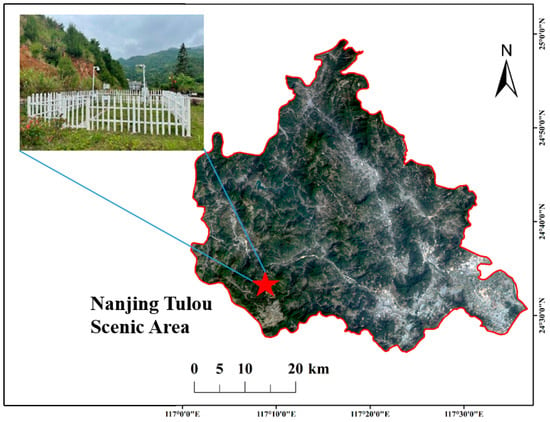
Figure 1.
The meteorological observation system in Nanjing Tulou Scenic Area; FR500 negative air ion monitor.
The data collection for air negative ion concentration and standard meteorological elements was recorded from April 2020 to May 2022. Subsequently, hourly averages of data were calculated. We used the FR500 negative air ion monitor, as shown in Figure 1, to measure the following meteorological factors: air temperature, atmospheric pressure, relative humidity, precipitation, wind speed, and visibility. The parameters were as follows: precipitation in 1 h (PRE, mm); average temperatures (TEM, °C); average atmospheric pressure (PRS, hPa); average relative humidity (RHU, %); average wind speed of 10 min to be averaged in 1 h (WIN, m/s); and visibility (VIS, m).
3. Data Processing and Analysis
3.1. Data Preprocessing
To ensure accurate and complete meteorological data, the collected data during instrument calibration must be processed to prevent any missing or abnormal records. Standardization is aimed at eliminating dissimilarity between the characteristics of NAI data to cancel out errors caused by different units of measurement, internal variations, or large numerical differences.
3.2. Outlier Elimination
Due to the large amount of variation in NAI concentrations data, it is difficult to identify outliers using conventional statistical screening methods (Figure 2). This study employed an integrated approach for outlier identification []. The NAI data screening consisted of two aspects: firstly, removing NAI data that did not meet the instrument’s standards or had obvious errors, and then selecting NAI data that met specific conditions while excluding data that did not meet those conditions. The specific methods used were as follows: (1) rapidly eliminating NAI concentrations outlier data using the “boxplot” method in the R program; (2) screening timeseries data to remove discontinuous and abnormal data caused by equipment storage interruptions and faults; (3) treating datapoints where either air relative humidity or NAI concentrations equaled 0 or 99,999 as outliers and labeling them as NA; and (4) comparing each value with the preceding and succeeding values and discarding those that were greater than three times or less than 1/3, labeling them as NA. (5) Six or more consecutive identical data values were treated as outliers and recorded as NA. During the monitoring process, a total of 526 entries were excluded due to weather-related malfunctions, accounting for 2.7%. Ultimately, 18,922 complete sets of data were successfully collected. After removing outliers, approximately 18,084 sets of valid data were obtained for further analysis.
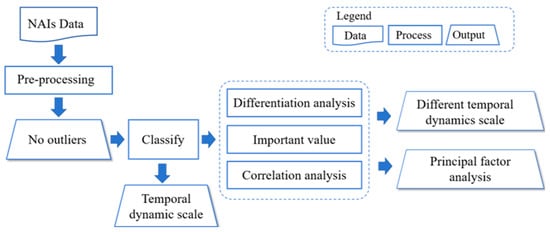
Figure 2.
General workflow.
3.3. Data Analysis
Following the principles of climatology, the months of April to May, June to August, September to November, and December to February of the following year were categorized as spring, summer, autumn, and winter, respectively []. After handling the outliers, the dataset was divided for analysis into hourly, daily, monthly, and quarterly averages. The monitoring period extended from 3 April 2020 to 31 May 2022, encompassing seasonal dynamics from summer 2020 to spring 2022.
Prior to data analysis, the normality of the data was checked. If the data conformed to a normal distribution, a one-way analysis of variance (ANOVA) was used to analyze differences in NAIs among different months, seasons, and years. Pearson correlation analysis was employed to examine the correlations between NAIs and variables such as air temperature, wind speed, and total rainfall. The random forest (RF) model was utilized to determine the importance of variables, including air temperature, wind speed, total rainfall and others on NAI concentrations. All data analysis was conducted using R 4.2.3, with the “mass” package for one-way ANOVA, the “random Forest” package for building the random forest model, and the “corrplot” package for Pearson correlation analysis [].
4. Results
4.1. Daily Dynamics
From 3 April 2020 to 26 May 2022, the daily variation of NAI concentrations exhibited a U-shaped curve with a daily average of 4827.54 ion/cm3 (Figure 3). NAI concentrations reached their first peak around 4:30 in the morning, with an average of 6302 ion/cm3. The second peak occurred around 10:45 at night, with an average of 6198 ion/cm3, while the minimum concentration was observed around 1:20 in the afternoon, with an average of 2671 ion/cm3.
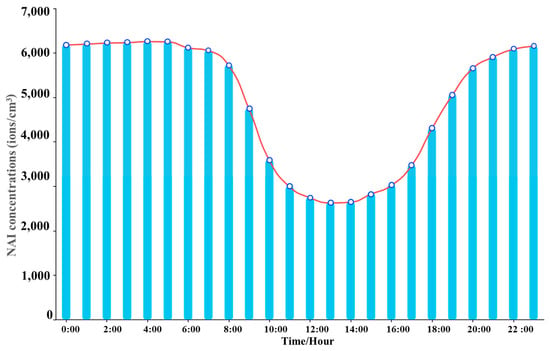
Figure 3.
Daily dynamic of NAIs from 2020 to 2022 in Nanjing, China.
The daily dynamics of NAI concentrations during each month of the monitoring period showed relatively complex variations. In the daily dynamics for different months, a U-shaped distribution was mainly observed, with the greatest variation in daily average concentration in July 2021 and the smallest variation in April 2020 (Figure 4). There were 15 months with consistent trends in daily dynamics, accounting for 60% of the monitored months (Figure 4). During the 2020 monitoring period, different trends were mainly observed, with daily dynamics tending to be more stable overall. In general, NAI concentrations were typically highest in the morning (4:30–8:00) or evening (19:10–22:00) and lowest around noon (12:50–14:45).
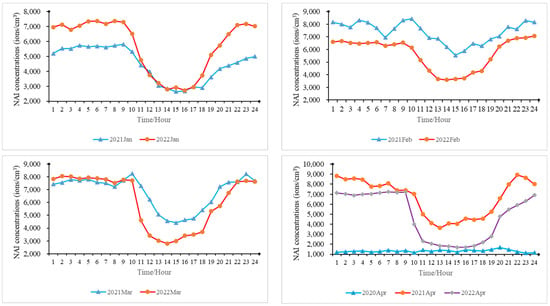
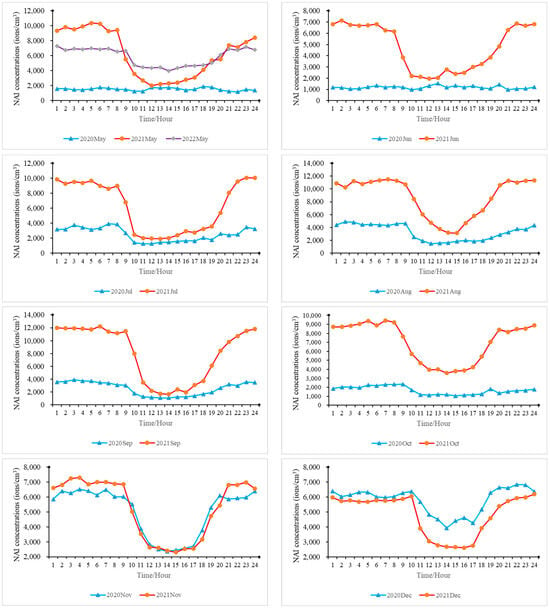
Figure 4.
Daily dynamic of NAIs in each month from 2020 to 2022 in Nanjing, China. Note: The hollow box represents the value that NAI concentrations of following year higher than the previous year, while the solid box represents the NAIs that the previous year higher than the following year.
4.2. Monthly Dynamics
The monthly variation of NAI concentrations during the monitoring period were all above 1000 ion/cm3 (Figure 5a). The monthly dynamics from April to October exhibited significant differences in NAI concentrations across different years, while the monthly dynamics from October to the following May showed relatively minor variations (Figure 5b). Starting from November 2020 and continuing until the end of the monitoring period, the monthly NAI concentrations consistently exceeded 4000 ion/cm3, with an overall mean of 4931 ion/cm3. The highest monthly average concentrations occurred in August 2021 at 8726.16 ion/cm3, while the lowest concentration was 1183.76 ion/cm3 in June 2020.
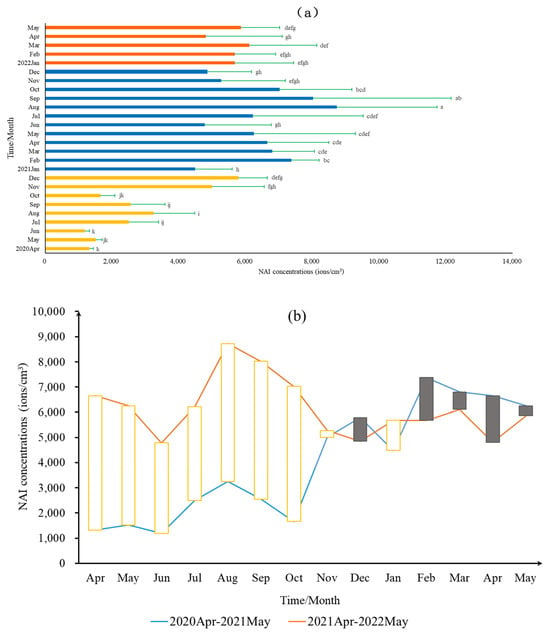
Figure 5.
Month dynamic of NAI concentrations from 2020 to 2022 in Nanjing in different months. Note: (a) NAI concentrations variation in each month. (b) Paired comparison of NAIs in each month. Different letters indicate significant differences in NAI concentrations among months at the 0.05 level.
The highest monthly concentration was approximately seven times that of the lowest monthly concentration, indicating significant differences at the monthly scale (Figure 5a). The months with the highest and lowest NAI concentrations varied across different years, with December being the highest in 2020 and June being the lowest, while in 2021, the highest was in August and the lowest in January. The monitoring in 2022 showed relatively stable fluctuations between 4600 and 6100 ion/cm3 (Figure 5a).
4.3. Seasonal Dynamics
NAI concentrations in the winter of 2020 were significantly higher than those in the other seasons of the same year. The concentrations in the summer and autumn of 2021 were significantly higher than those in the same seasons in different years, with no significant differences observed in the spring and winter in 2021 (p > 0.05). During the monitoring period, the average NAI concentrations for each season from summer 2020 to spring 2022 were 2310.34 ion/cm3, 3070.73 ion/cm3, 5880.59 ion/cm3, 6568.63 ion/cm3, 6576.05 ion/cm3, 6768.53 ion/cm3, 5401.09 ion/cm3, and 5592.02 ion/cm3, respectively (Figure 6). The NAI concentrations during summer were 21.75% higher than those in winter. The monthly average concentrations in spring, autumn, and winter remained relatively stable in 2021.
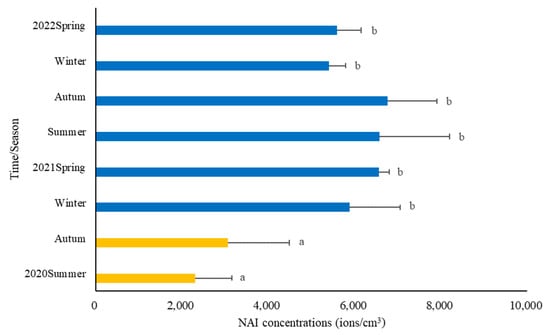
Figure 6.
NAI concentrations in different seasons.
4.4. NAI Concentrations Grading
There were no instances of unfavorable NAI concentrations in any of the 26 months. In addition to the trends observed, a detailed breakdown of concentration levels can be found in Table S1 of Supplementary Material []. Starting from May 2020, NAI concentrations consistently maintained levels categorized as either favorable or outstanding, with the “intermediate” level observed only in April 2020 for a single day, showcasing a daily average NAI concentration of 670.08 ions/cm3 (Figure 7). Examining the seasonal patterns in 2020, the summer season demonstrated a favorable level of NAI concentrations, constituting 15.22% of the total. The autumn season exhibited a favorable level of 8.79%, while the winter season was characterized as outstanding. From 2021 to 2022, NAI concentrations in each month consistently reached an outstanding level (Figure 7).
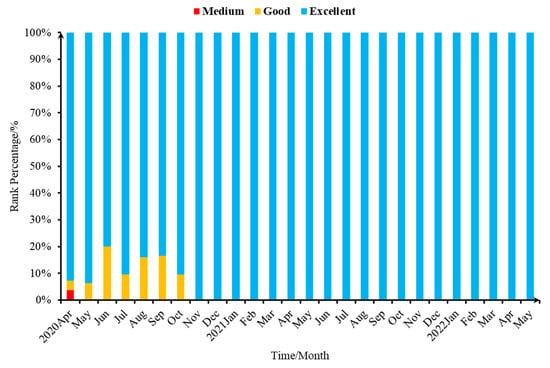
Figure 7.
Percentages of NAI concentration grades in different months.
4.5. Importance and Correlation Analysis
The importance of output variables in the random forest model on NAI impact was as follows: air temperature, relative humidity, air quality index, local atmospheric pressure, 10 min wind speed, 10 min wind direction, 2 min wind direction, 2 min wind speed, and precipitation (Figure 8a). NAI concentrations had a significantly positive correlation with relative humidity (p < 0.01) (Figure 8b). NAI concentrations were significantly negatively correlated with air temperature and air quality index (p < 0.01) and positively correlated with 2 min wind speed and 10 min wind speed (p < 0.05). NAI concentrations had no obvious correlation relationship with 2 min or 10 min wind direction and precipitation.
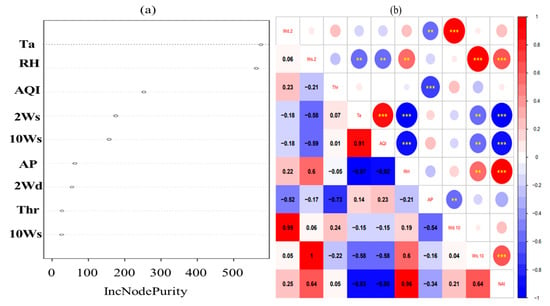
Figure 8.
Important value (a) and correlation analysis (b) of different environmental factors. Note: IncNodePurity indicates the purity of nodes. The higher the purity of nodes, the greater the importance. Wd-2, Ws-2, Thr, Ta, AQI, RH, Wd-10, Ws-10, AP, and NAIs represent 2 min wind direction, 2 min wind speed, hourly rainfall, air temperature, air quality index, relative humidity, local air pressure and NAIs, respectively. Red means a positive correlation, and blue means a negative correlation. “**” and “***” are significant at the 0.05 and 0.01 level, respectively.
5. Discussion
5.1. Temporal Dynamics of NAI Concentrations
The daily variation of NAI concentration in Nanjing Tulou displayed a U-shaped pattern (Figure 3). The peak of NAI concentrations generally occurred in the early morning (4:30–8:00) and afternoon (19:10–22:00), and the minimum values presented at approximately noon (12:50–14:45). Our results were consistent with the studies in the Wudalianchi Scenic Area and Mount Hengshan in South China [,]. However, they differed from the results for NAI concentrations in the Fuyang District of Hangzhou and Beijing city, respectively, which presented as a bimodal distribution curve [,].
The lowest value of NAI concentrations occurred around noon. Photosynthesis by plants is a significant source of NAIs in the forest environment. After noon, as air temperature rises and humidity decreases, plant leaf stomata partially close, leading to a reduction in photosynthesis. This results in a sharp decrease in the number of NAIs generated through the photoelectric effect on leaf surfaces, causing NAI concentrations to decrease [,,]. During the night, water vapor condenses into droplets that adsorb and deposit dust particles [,]. This process creates a cleansing effect, reduces the density of condensation nuclei in the air and improves air quality [,]. It suggests that NAIs are more likely to accumulate in clean environments, leading to higher NAI concentrations in the early morning []. Additionally, air pollutants generated by human activities, such as particulate matter and sulfur dioxide, could decrease NAI concentrations []. After midnight, with a decreasing number of tourists and a reduction in pollutant emissions, NAI concentrations gradually increase and reach their maximum in the morning [,]. Furthermore, Nanjing Tulou’s proximity to a small canyon and a river enhances wind speeds, which promotes the dispersion of pollutants, resulting in an increase in NAI concentrations after sunset [,].
By using a grading method to illustrate the NAI concentrations in different months or seasons in the Nanjing Tulou scenic area, the monthly average NAI concentration was 4931 ion/cm3. The peak values occurred in the summer and autumn seasons. During the period from winter 2020 to winter 2021, the NAI concentrations exceeded 5000 ion/cm3 in each season, with 6768.53 ion/cm3 in the autumn season (Figure 5a and Figure 6). Autumn’s reduced rainfall and relative humidity result in drier air, enhancing water molecule evaporation and NAI generation. The cooler temperature fosters stable NAIs, thus intensifying their concentration. Furthermore, autumn’s abundant vegetation emits increased VOCs that react with NAIs, forming NAIs and further elevating NAI concentrations [,,]. This concentration meets international standards and can satisfy the basic physiological needs of the human body, promoting physical recovery and wellbeing. It is suitable for activities such as forest therapy and ecotourism [,,]. The very substantial monthly variation in NAI concentrations can be attributed to seasonal variations in vegetation growth and variations in monthly air temperature, relative humidity, and radiation levels [,]. Due to the contribution of streams to atmospheric moisture and the influence of terrain and vegetation on NAIs, the area is highly sensitive to fluctuations in NAI concentrations [,]. However, August had the highest monthly concentrations, primarily because August’s weather was favorable—high air temperature and relative humidity are ideal for producing NAIs []. Conversely, human gatherings and activities can disrupt the generation and dispersion of NAIs, leading to irregular fluctuations in NAI concentrations [,].
The NAI concentration data for 2020 significantly differs from that of 2021 and 2022 (Figure 6), with these variances attributed to meteorological factors and human activities. Comparative meteorological analysis indicates higher air temperatures, lower relative humidity, and reduced rainfall during the summer and autumn of 2020. A correlation between NAI concentrations and these meteorological factors (Figure 8) during this period resulted in a noteworthy decrease in NAI concentrations compared to other seasons. Reduced population flow decreases pollutant emissions, promoting smoother NAI generation and dispersion, potentially leading to higher concentrations [,,]. Lin et al. (2022) correlated tourism climate comfort with passenger flow using meteorological data from 2017 to 2019. They found that the comfort level during autumn is higher, making it more suitable for travel in the Nanjing Tulou scenic area []. In the Nanjing Tulou scenic area, NAI concentrations reach their peak between 5 a.m. and 8 a.m. and after 5 p.m., making this period optimal for climate observation activities such as “The Most Beautiful Starry Sky”. Summer and autumn are good seasons for ecotourism. This season is preferable for activities that promote mental and physical wellbeing.
5.2. Environmental Factor Effects on NAI Concentrations
The elevation of NAI levels in the environment involves complex multifactorial influences requiring in-depth academic research. Various geographical and meteorological conditions may influence the generation and distribution of airborne particles in the atmosphere, consequently affecting the variation in NAI concentrations [,,]. However, given the multitude of factors influencing NAIs and considering the availability of data (Figure S1 of Supplementary Material), I will focus primarily on its analysis.
Air temperature and relative humidity are critical factors influencing the concentration of NAIs. Lower air temperature and higher relative humidity promote the generation and stability of NAIs, while higher air temperature and lower relative humidity impede their production [,,]. Among these factors, air temperature is of utmost significance, showing a significant negative correlation with NAI concentrations (p < 0.01) (Figure 8b). The observed difference can be ascribed to the incorporation of elevated concentrations of large ions and intermediate-sized ions in our NAI measurements [,]. Primarily, this is linked to high temperatures causing a decrease in atmospheric water vapor, which is a vital source for negative ion generation [,]. Consequently, increasing air temperature can reduce the production of negative ions. Furthermore, higher temperatures can shorten the lifespan of negative ions because under high-temperature conditions, other atmospheric molecules are more likely to collide with negative ions, leading to a loss of stability [].
Water is considered a crucial factor in the generation process of NAIs, as it directly participates in NAI reactions []. As relative humidity increases, water vapor in the air condenses into water droplets. These water droplets play a cleansing role in the atmosphere’s particulate matter, which can extend the lifespan of NAIs [,]. Relative humidity ranked second in importance among factors influencing NAIs in the random forest model and exhibited a highly significant positive correlation with NAI concentrations (p < 0.01) (Figure 8b). The augmentation of water molecules, particularly induced by rainfall, constitutes a crucial factor contributing to the escalation of NAI concentrations. This occurs through the elevation of atmospheric water content, thereby influencing the generation of NAIs [,,].
Furthermore, lower AQI indicates a better air quality, resulting in higher NAI concentrations. From a statistical perspective, there is a significant negative correlation (−0.88) between the AQI and NAI concentrations, indicating that higher NAI concentrations are associated with better air quality. However, to determine if the levels of NAI concentrations can dictate the levels of AQI, a thorough mechanistic study is required [,,]. Our long-term monitoring of AQI indices and NAI concentrations aims to explore the patterns of their changes and influences, thus providing insights for future mechanistic research.
5.3. Limitations of this Study
Currently, research on negative air ions primarily focuses on understanding the regularities of their concentration. Mechanistically, the impact of environmental factors, particularly weather conditions, on NAI concentrations is attributed to the state changes within the ions, specifically between large and small ions [,,]. In detail, the horizontal movement of small air ions may lead to a reduction in NAI concentrations through charge transfer from small to large ions, and small ions are considered more beneficial to human health [,,,,,]. The longer lifespan of large ions allows them to accumulate to higher concentrations in the air. Weather conditions, such as rainfall, may act to remove air ions of varying sizes [,,].
It is noteworthy that the role of large and small ions in the generation and regulation of NAI concentrations remains a relatively underexplored research topic. Despite some attention in existing studies, further in-depth investigations are warranted. One potential avenue for future research involves simultaneous measurement and monitoring of NAI concentrations for both large and small ions. Such research designs will contribute to a more comprehensive understanding of the mechanisms governing the generation and distribution of NAIs.
6. Conclusions
Through the continuous monitoring of NAI concentrations and environmental factors in Nanjing Tulou over 26 consecutive months, we investigated the temporal dynamics of NAI concentrations and their relationship with environmental factors. NAI concentrations exhibited significant temporal variations and were closely related to environmental factors. Air temperature and air quality index had significant negative effects on NAI concentrations, while relative humidity had a significant positive effect. Urban people are more suitable for recreational activities in the early morning and evening in summer and autumn. At this stage, this research may provide new insights into the NAI temporal dynamic patterns and their driving factors, as well as aid in scheduling outdoor recreation and forest health activities for urban people.
Supplementary Materials
The following supporting information can be downloaded at: https://www.mdpi.com/article/10.3390/atmos15030258/s1, Figure S1: The time distribution trend chart of environmental factors and NAI concentrations; Table S1: Effects of NAI concentrations grades on human health.
Author Contributions
Z.L., J.L. and C.L. designed this study and experiment. C.L. and Z.L. collected the data. Z.L. and B.C. conducted the data analysis. Z.L., C.L. and Z.H. provided the statistical methods. Z.L., Y.H. and B.C. implemented the random forest model. Z.L., J.L. and C.L. drafted the paper. Z.L., B.C., Z.H., Y.H., L.J., J.L. and C.L. edited the paper. All authors have read and agreed to the published version of the manuscript.
Funding
The research received the financial support from the Forestry Technology Research Project of Fujian Province, grant number 2023FKJ22 and 2021FKJ10; the Fujian Natural Science Foundation, grant number 2022J011133 and 2022J05266; the National Natural Science Foundation, grant number 42101238; and Enterprise Technical Services, grant number KH230098A.
Institutional Review Board Statement
Not applicable.
Informed Consent Statement
Not applicable.
Data Availability Statement
The data presented in this study are within the article.
Acknowledgments
We wish to express our thanks for the support received from the Nanjing County Meteorological Bureau, as well as for allowing us to collect samples. We express our gratitude to Director Huang Hua and Senior Engineer Liao Yanzhen for their assistance during the on-site investigation. The authors would like to thank Ziyang Xie for their help with the review and providing suggestions. Thank you for the companionship and encouragement from YuJing Guo. Furthermore, we want to express our thanks to the reviewers for their valuable insights, which significantly improved our manuscript.
Conflicts of Interest
The authors declare no conflict of interest.
References
- Alexander, D.D.; Bailey, W.H.; Perez, V.; Mitchell, M.E.; Su, S. Air ions and respiratory function outcomes: A comprehensive review. J. Negat. Results Biomed. 2013, 12, 14. [Google Scholar] [CrossRef] [PubMed]
- Goldstein, N.; Arshavskaya, T.V. Is atmospheric superoxide vitally necessary? Accelerated death of animals in a quasi-neutral electric atmosphere. Z. Naturforschung C 1997, 52, 396–404. [Google Scholar] [CrossRef]
- Ling, D. Review on research of the negative air ion concentration distribution and its correlation with meteorological elements in mountain tourist area. Earth Sci. 2019, 8, 60–68. [Google Scholar] [CrossRef][Green Version]
- Li, A.B.; Li, Q.L.; Zhou, B.Z.; Ge, X.G.; Gao, Y.H. Temporal dynamics of negative air ion concentration and its relationship with environmental factors: Results from long-term on-site monitoring. Sci. Total Environ. 2022, 832, 155057. [Google Scholar] [CrossRef] [PubMed]
- Miao, S.; Zhang, X.; Han, Y.; Sun, W.; Liu, C.J.; Yin, S. Random forest algorithm for the relationship between negative air ions and environmental factors in an urban park. Atmosphere 2018, 9, 463. [Google Scholar] [CrossRef]
- Li, A.B.; Zhao, X.W.; Li, C.Y.; Zhou, B.Z.; Yang, Z.Y.; Zhou, P.P.; Zhao, Y.M. Relationship of plant abundance, air temperature and humidity with negative ions based on control experiment. J. Appl. Ecol. 2019, 30, 2211–2217. [Google Scholar]
- Bowers, B.; Flory, R.; Ametepe, J.; Staley, L.; Patrick, A.; Carrington, H. Controlled trial evaluation of exposure duration to negative air ions for the treatment of seasonal affective disorder. Psychiatry Res. 2018, 259, 7–14. [Google Scholar] [CrossRef] [PubMed]
- Lorenz, P.J. Air Ion Densities in a Smoke-Filled Room. Proc. Iowa Acad. Sci. 1961, 68, 452–460. [Google Scholar]
- Charry, J.M. Biological effects of small air ions: A review of findings and methods. Environ. Res. 1984, 34, 351–389. [Google Scholar] [CrossRef]
- Shi, G.Y.; Huang, H.; Sang, Y.Q.; Cai, L.L.; Zhang, J.S.; Cheng, X.F.; Qiao, Y.S. Solar-induced chlorophyll fluorescence intensity has a significant correlation with negative air ion release in forest canopy. Atmos. Environ. 2022, 269, 118873. [Google Scholar] [CrossRef]
- Yun, J.; Yao, W.; Wang, X.; Chen, F.; Wang, S. Daily dynamics of forest air negative ion concentration in spring and the relationship of influencing factors: Results of field monitoring. Air Qual. Atmos. Health 2023, 1–11. [Google Scholar] [CrossRef]
- Chen, Q.; Wang, R.; Zhang, X.P.; Liu, J.J.; Wang, D.X. Effects of different site conditions on the concentration of negative air ions in mountain forest based on an orthogonal experimental study. Sustainability 2021, 13, 12012. [Google Scholar] [CrossRef]
- Yoon, Y.H.; Lee, S.H.; Kim, J.H. Evaluation of Air Ion According to Vegetation Types in Valleys and Slopes-Focused on Tangeumdae Park in ChungJu. J. Environ. Sci. Int. 2020, 29, 519–529. [Google Scholar] [CrossRef]
- Xie, Z.Y.; Li, C.S.; Lin, Y.; Liu, J.F.; He, Z.S. The Lagging Effect of Precipitation on NAIs Concentrations on Rainy Days in Wuyi Mountain National Park, China. Atmosphere 2023, 14, 377. [Google Scholar] [CrossRef]
- Wang, H.; Wang, B.; Niu, X.; Song, Q.F.; Li, M.W.; Luo, Y.Y.; Liang, L.D.; Du, P.F.; Peng, W. Study on the change of negative air ion concentration and its influencing factors at different spatio-temporal scales. Glob. Ecol. Conserv. 2020, 23, e01008. [Google Scholar] [CrossRef]
- Cui, Y.; Zhao, Y.X.; Zhang, N.; Zhang, D.Y.; Yang, J.N. An inversion model for estimating the negative air ion concentration using MODIS images of the Daxing’anling region. PLoS ONE 2020, 15, e0242554. [Google Scholar]
- Liang, H.; Chen, X.S.; Yin, J.G.; Da, L.J. The spatial-temporal pattern and influencing factors of negative air ions in urban forests, Shanghai, China. J. For. Res. 2014, 25, 847–856. [Google Scholar] [CrossRef]
- Shao, H.R.; He, Q.T.; Yan, H.G.; Hou, Z.; Li, T. Spatio-temporal changes of negative air ion concentrations in Beijing. J. Beijing For. Univ. 2005, 27, 35–39. (In Chinese) [Google Scholar]
- Tao, S.C.; Sun, Z.C.; Lin, X.W.; Zhang, Z.Z.; Wu, C.F.; Zhang, Z.Y.; Zhou, B.Z.; Zhao, Z.; Cao, C.C.; Guan, X.Y.; et al. Negative Air Ion (NAI) Dynamics over Zhejiang Province, China, Based on Multivariate Remote Sensing Products. Remote Sens. 2023, 15, 738. [Google Scholar] [CrossRef]
- Lin, R.H.; Li, C.S.; Liao, Y.Z.; Meng, B.X. Correlation Analysis of Climate Comfort and Annual Changes in Passenger Flow in Nanjing Tulou Tourism. Straits Sci. 2022, 185, 100–103. (In Chinese) [Google Scholar]
- Jiang, Z. The Research of Development Models Based on Culture Creative Tourism Industry: Example as Fujian Nanjing Tulou. In Proceedings of the 2011 International Conference on Management and Service Science, Wuhan, China, 12–14 August 2011; IEEE: Piscataway, NJ, USA, 2011; pp. 1–3. [Google Scholar]
- Liao, C.Z.; Hou, M.; Zhuo, L.; Huang, G.L.; Tang, X.P. Study on Establishment of the Technical System for Monitoring Air Negative Oxygen Ion in China. For. Resour. Manag. 2019, 3, 20. (In Chinese) [Google Scholar]
- Li, C.S.; Xie, Z.Y.; Chen, B.; Kuang, K.J.; Xu, D.W.; Liu, J.F.; He, Z.S. Different time scale distribution of negative air ions concentrations in Mount Wuyi National Park. Int. J. Environ. Res. Public Health 2021, 18, 5037. [Google Scholar] [CrossRef] [PubMed]
- R Core Team. R: A Language and Environment for Statistical Computing (Version 4.2.3). R Foundation for Statistical Computing. 2023. Available online: https://www.R-project.org/ (accessed on 8 May 2023).
- Wu, C.C.; Zheng, Q.M.; Zhong, L.S. A study of the aero-anion concentration in forest recreation area. Sci. Silvae Sin. 2001, 37, 75–81. [Google Scholar]
- Wu, C.C.; Lee, G.W.M.; Yang, S.; Yu, K.P.; Luo, C.L. Influence of air humidity and the distance from the source on negative air ion concentration in indoor air. Sci. Total Environ. 2006, 370, 245–253. [Google Scholar] [CrossRef] [PubMed]
- Yu, J.; Gao, Z.D.; Wang, D.Y.; Wang, H.C.; Mei, Z.M. Analysis of temporal and spatial distribution characteristics and influencing factors of air anions in Tianyuan cave. Environ. Chem. 2021, 40, 1078–1087. (In Chinese) [Google Scholar]
- Shi, G.Y.; Zhou, Y.; Sang, Y.Q.; Huang, H.; Zhang, J.S.; Meng, P.; Cai, L.L. Modeling the response of negative air ions to environmental factors using multiple linear regression and random forest. Ecol. Inform. 2021, 66, 101464. [Google Scholar] [CrossRef]
- Lee, S.H.; Gordon, H.; Yu, H.; Lehtipalo, K.; Haley, R.; Li, Y.X.; Zhang, R.Y. New particle formation in the atmosphere: From molecular clusters to global climate. J. Geophys. Res. Atmos. 2019, 124, 7098–7146. [Google Scholar] [CrossRef]
- Zhang, Z.Z.; Tao, S.C.; Zhou, B.Z.; Zhang, X.Y.; Zhao, Z. Plant stomatal conductance determined transpiration and photosynthesis both contribute to the enhanced negative air ion (NAI). Ecol. Indic. 2021, 130, 108114. [Google Scholar] [CrossRef]
- Suwardi, A.; Ooi, C.C.; Daniel, D.; Tan, C.K.I.; Li, H.Y.; Liang, O.Y.Z.; Tang, Y.K.; Chee, J.Y.; Sadovoy, A.; Jiang, S.Y.; et al. The efficacy of plant-based ionizers in removing aerosol for COVID-19 mitigation. Research 2021, 2021, 2173642. [Google Scholar] [CrossRef]
- Zhang, C.; Wu, Z.; Li, Z.; Li, H.F.; Lin, J.M. Inhibition effect of negative air ions on adsorption between volatile organic compounds and environmental particulate matter. Langmuir 2020, 36, 5078–5083. [Google Scholar] [CrossRef]
- Ma, H.; Li, S.; Chan, C.S. Analytic Hierarchy Process (AHP)-based assessment of the value of non-World Heritage Tulou: A case study of Pinghe County, Fujian Province. Tour. Manag. Perspect. 2018, 26, 67–77. [Google Scholar] [CrossRef]
- Albrechtsen, O.; Clausen, V.; Christensen, F.G.; Jensen, J.G.; Mealier, T. The influence of small atmospheric ions on human well-being and mental performance. Int. J. Biometeorol. 1978, 22, 249–262. [Google Scholar] [CrossRef] [PubMed]
- Jungwirth, P.; Tobias, D.J. Specific ion effects at the air/water interface. Chem. Rev. 2006, 106, 1259–1281. [Google Scholar] [CrossRef] [PubMed]
- Jiang, S.Y.; Ma, A.; Ramachandran, S. Negative air ions and their effects on human health and air quality improvement. Int. J. Mol. Sci. 2018, 19, 2966. [Google Scholar] [CrossRef]
- Luo, L.H.; Sun, W.; Han, Y.J.; Zhang, W.W.; Liu, C.J.; Yin, S. Importance evaluation based on random forest algorithms: Insights into the relationship between negative air ions variability and environmental factors in urban green spaces. Atmosphere 2020, 11, 706. [Google Scholar] [CrossRef]
- Li, Y.R.; Chen, X.T.; Jiang, J.K. Measuring size distributions of atmospheric aerosols using natural air ions. Aerosol Sci. Technol. 2022, 56, 655–664. [Google Scholar] [CrossRef]
- Liu, Z.H.; Zhang, Q.H.; Xie, D.G.; Zhang, M.Z.; Li, X.Y.; Zhong, H.; Li, G.; He, M.; Shang, D.S.; Wang, C.; et al. Interface-type tunable oxygen ion dynamics for physical reservoir computing. Nat. Commun. 2023, 14, 7176. [Google Scholar] [CrossRef] [PubMed]
- Yang, Y.C.; Zhang, X.X.; Qin, L.; Zeng, Q.B.; Qiu, X.H.; Huang, R. Probing nanoscale oxygen ion motion in memristive systems. Nat. Commun. 2017, 8, 15173. [Google Scholar] [CrossRef] [PubMed]
- Hirsikko, A.; Nieminen, T.; Gagné, S.; Lehtipalo, K.; Manninen, H.E.; Ehn, M.; Horrak, U.; Kerminen, V.M.; Laakso, L.; McMurry, P.H.; et al. Atmospheric ions and nucleation: A review of observations. Atmos. Chem. Phys. 2011, 11, 767–798. [Google Scholar] [CrossRef]
- Shuman, N.S.; Hunton, D.E.; Viggiano, A.A. Ambient and modified atmospheric ion chemistry: From top to bottom. Chem. Rev. 2015, 115, 4542–4570. [Google Scholar] [CrossRef]
- Pushpawela, B.; Jayaratne, R.; Nguy, A.; Morawska, L. Efficiency of ionizers in removing airborne particles in indoor environments. J. Electrost. 2017, 90, 79–84. [Google Scholar] [CrossRef]
- Belostotsky, S.G.; Economou, D.J.; Lopaev, D.V.; Rakhimova, T.V. Negative ion destruction by O (3P) atoms and O2 (a 1Δg) molecules in an oxygen plasma. Plasma Sources Sci. Technol. 2005, 14, 532. [Google Scholar] [CrossRef]
- Chalmers, J.A. Atmospheric Electricity: International Series of Monographs in Natural Philosophy; Elsevier: Amsterdam, The Netherlands, 2013; Volume 11. [Google Scholar]
Disclaimer/Publisher’s Note: The statements, opinions and data contained in all publications are solely those of the individual author(s) and contributor(s) and not of MDPI and/or the editor(s). MDPI and/or the editor(s) disclaim responsibility for any injury to people or property resulting from any ideas, methods, instructions or products referred to in the content. |
© 2024 by the authors. Licensee MDPI, Basel, Switzerland. This article is an open access article distributed under the terms and conditions of the Creative Commons Attribution (CC BY) license (https://creativecommons.org/licenses/by/4.0/).